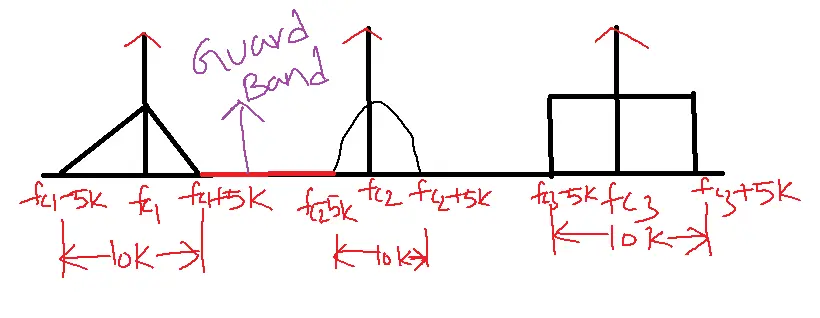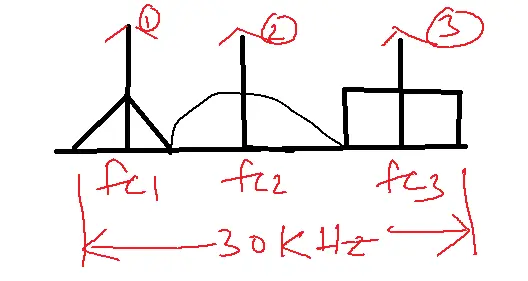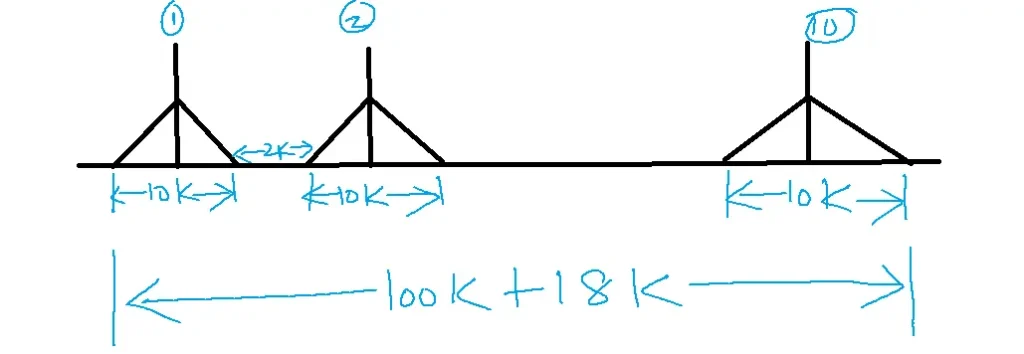In Analog Communication systems frequency division multiplexing is used.
When more than one signal is sent through the same communication channel, the technique is known as multiplexing.

Low pass filters are used to eliminate the insignificant high frequencies.
Assume that all signals are band-limited to 5 KHz.
The signals are modulated to different carrier frequencies: the first to fc1, the second to fc2, and the third to fc3.
Table of Contents
The type of modulation technique depends on the application.
Assume that all modulators are AM. The spectrum of the multiplexed signal is shown in the figure.

The carrier frequencies are selected so that the signals are not overlapping. The spectral gap between the signals is called the guard band. The spectrum of the multiplexed signal without a guard band is shown in the figure.

Bandwidth without guard band is 30 KHz.
With a guard band of 1 KHz, the bandwidth of the multiplexed signal is 32 KHz.
The receiver utilizes a bandpass filter to isolate the desired signal. To select the first signal the centre frequency should be fc1.
The absence of a guard band implies the need for an ideal filter, an impossibility in practical implementations. The role of the demodulator is to convert the high-frequency signal into a low-frequency signal.
In radio and TV, only one signal is demodulated at a time. A tuned circuit is used as the bandpass filter in radio and TV. The process of selecting the required signal is called tuning.
Frequency division multiplexing-related problems:
1. 10 signals each band limited to 5 KHz are transmitted through a channel after modulation using frequency division multiplexing. The guard band is 2 KHz. Determine the bandwidth of the multiplexed signal
i. If all modulators are AM
ii. If all modulators are DSB
iii. If all modulators are SSB
Solution: i.118 KHz
ii.118 KHz
iii. 68 KHz

2. Three signal bands limited to 5 KHz, 10 KHz, and 20 KHz are transmitted through a channel after modulation using frequency division multiplexing. The modulators used are AM, SSB, and DSB. Determine the bandwidth of the multiplexed signal if the guard band is 2 KHz.
Solution:

Applications of FREQUENCY DIVISION MULTIPLEXING (FDM)
- Television Broadcasting: FDM enables multiple TV channels to be transmitted over a single cable or broadcast signal.
- FM Radio Broadcasting: Multiple FM radio stations share the same frequency band using FDM, allowing for diverse programming choices.
- Telephone Systems: FDM is used in analog telephone systems to carry multiple voice conversations over a single pair of wires.
- Cable TV Systems: Cable TV providers use FDM to deliver various channels through coaxial cables.
- Microwave Links: FDM is employed in microwave communication systems to carry multiple data streams over a single microwave link.
- Satellite Communication: Satellites utilize FDM to transmit multiple signals simultaneously, enabling TV broadcasts, internet access, and other services.
- DSL Internet Access: FDM is used in DSL technology to separate voice and data signals over the same telephone line.
- Amateur Radio: Amateur radio operators use FDM to communicate on different frequency bands and modes.
- Audio Recording: By utilizing FDM in multi-track recording, engineers can isolate and capture individual instruments or vocals on dedicated tracks.
- Medical Imaging: FDM techniques are sometimes employed in imaging modalities like ultrasound and MRI.
Conclusion:
Frequency Division Multiplexing (FDM) is essential for today’s communication networks, optimizing bandwidth usage and allowing multiple signals to travel simultaneously. Whether listening to the radio or flipping through cable channels, FDM is essential for bringing those signals to your devices.
While FDM faces some limitations, its simplicity and cost-effectiveness make it a valuable tool for various applications. As technology evolves, FDM continues to adapt, ensuring it remains relevant in the ever-changing field of communication.
FAQs related to the topic
Q1. What is Frequency Division Multiplexing (FDM)?
- FDM is a technique where the total bandwidth of a communication channel is divided into smaller, non-overlapping frequency bands. Each band carries a separate signal, enabling multiple signals to be transmitted simultaneously.
Q2. How does FDM work?
- FDM functions by varying each input signal onto a different carrier frequency within the allocated frequency band. These modulated signals are then combined and transmitted over a shared medium. At the receiver, filters separate the individual signals based on their carrier frequencies.
Q3. What are the advantages of using FDM?
- Efficient use of bandwidth
- Reduced interference between signals
- Simple and cost-effective implementation
Q4. What are the disadvantages of FDM?
- Limited number of channels due to fixed bandwidth allocation
- Inefficient use of bandwidth if some channels are underutilized
- Susceptible to intermodulation distortion
Q5. What are the applications of FDM?
- Television broadcasting
- FM radio broadcasting
- Telephone systems
- Cable TV systems
- Microwave links
- Satellite communication
Q6. What is the difference between FDM and Time Division Multiplexing (TDM)?
- FDM divides the bandwidth into frequency bands, while TDM divides the time into slots. FDM is suitable for continuous signals, while TDM is better for bursty data.
Q7. What is a guard band in FDM?
- A guard band is an unused frequency band between adjacent channels in FDM. It helps to prevent interference between channels.
Q8. What is the role of filters in FDM?
- Filters are used in both the transmitter and receiver of an FDM system. At the transmitter, they limit the bandwidth of each signal to its allocated frequency band.
- Each signal is recovered at the receiver by separating them according to their unique carrier frequencies.
Q9. Is FDM still used today?
- FDM remains a prevalent technology in diverse applications, notably in radio and television broadcasting, cable TV infrastructure, and certain older telephone systems.
Q10. What are some alternatives to FDM?
- Time Division Multiplexing (TDM)
- Code Division Multiplexing (CDM)
- Orthogonal Frequency Division Multiplexing (OFDM)
- Wavelength Division Multiplexing (WDM) for optical communication
